Keisuke Yoshihara (University of Pennsylvania)
Research
Operation of Transition radiation tracker (2016 - present)
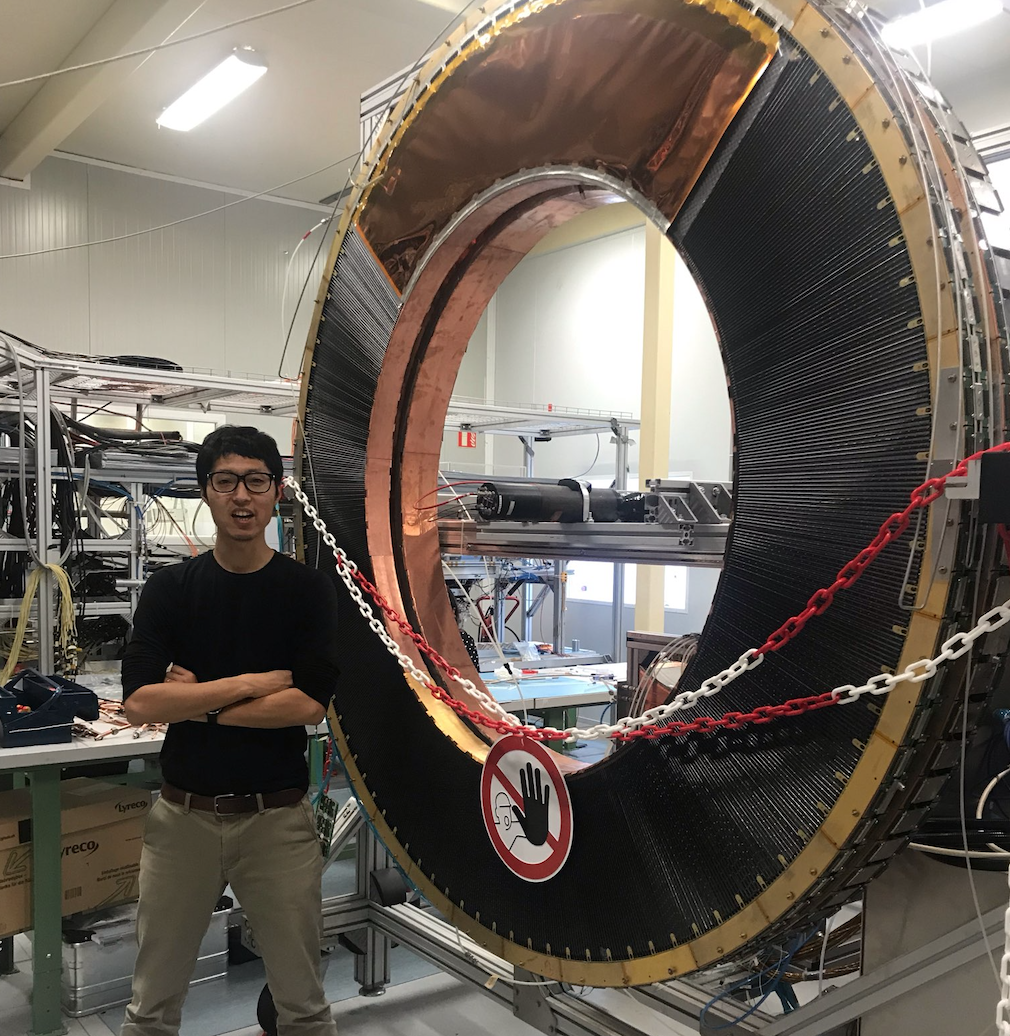 The ATLAS Transition radiation tracker (TRT) is the outermost inner detector subsystem, providing additional discrimination against hadrons in the identification of electrons. I coordinated the operation of the ATLAS TRT detector, taking responsibility for the full TRT readout chain, both electronics and the TRT
DAQ system. Our responsibilities include diagnosing problems as they arise, replacing failed off-detector electronics and maintaining, via repair and testing, an adequate supply of spares for the PP2 receiver-driver cards. We have also been in charge of the calibration of the TRT straw hits, firmware testing, and maintenance of the TRT software to accommodate changes in the ATLAS central DAQ software. This work is essential to smooth ATLAS data-taking. Operational efficiencies near 100% have been achieved so far, despite the challenges of increasing luminosity and the high-pileup environment.
The ATLAS Transition radiation tracker (TRT) is the outermost inner detector subsystem, providing additional discrimination against hadrons in the identification of electrons. I coordinated the operation of the ATLAS TRT detector, taking responsibility for the full TRT readout chain, both electronics and the TRT
DAQ system. Our responsibilities include diagnosing problems as they arise, replacing failed off-detector electronics and maintaining, via repair and testing, an adequate supply of spares for the PP2 receiver-driver cards. We have also been in charge of the calibration of the TRT straw hits, firmware testing, and maintenance of the TRT software to accommodate changes in the ATLAS central DAQ software. This work is essential to smooth ATLAS data-taking. Operational efficiencies near 100% have been achieved so far, despite the challenges of increasing luminosity and the high-pileup environment.
Scalar top-quark search (2015 - present)
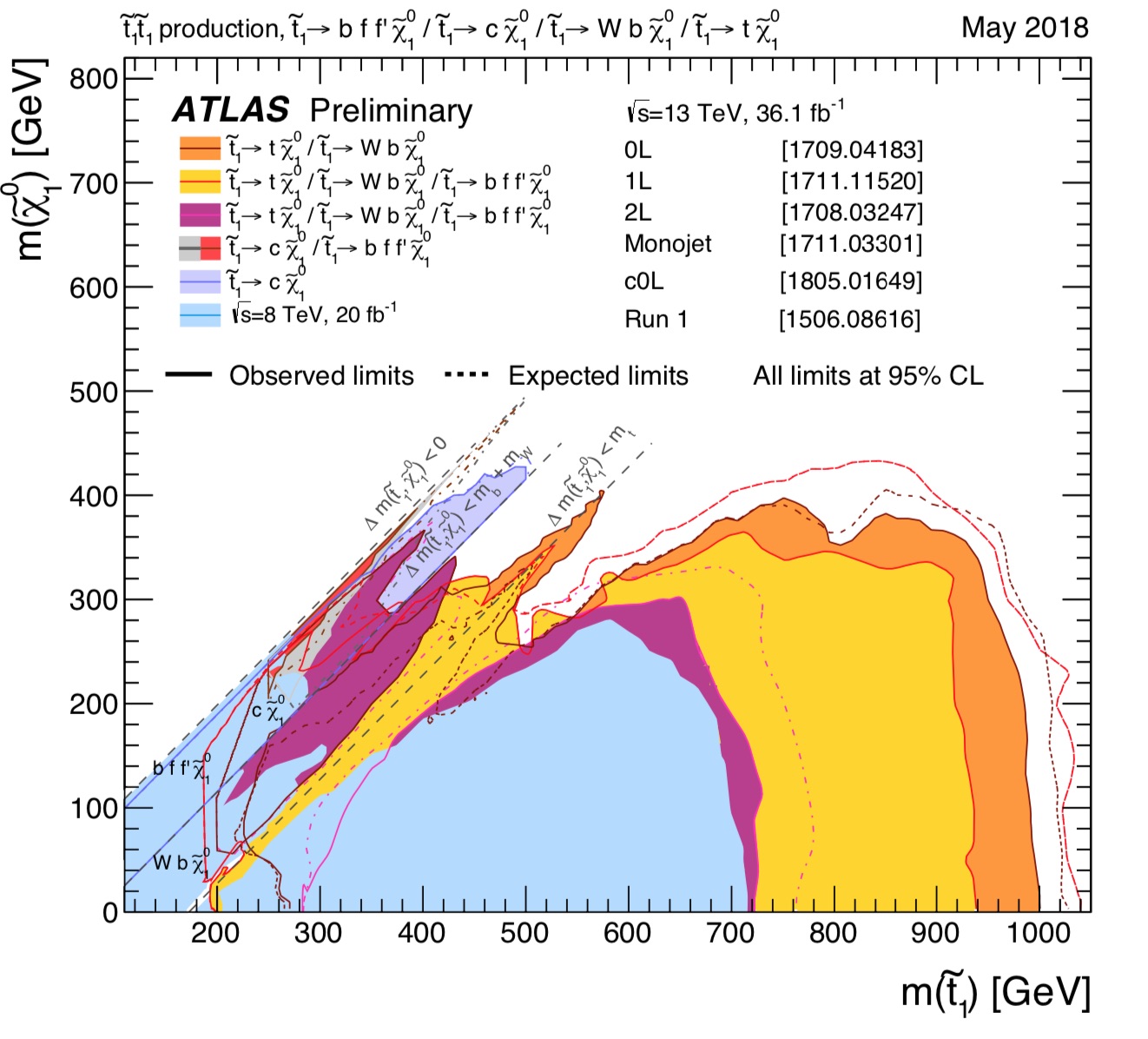 Supersymmetry (SUSY) is one of the most compelling and beautiful theories to solve hierarchy problem. In R-parity conserving models such as MSSM, SUSY particles can be produced in pairs and the lightest supersymmetric particle (LSP) is known to be stable. The superpartner of the top quark, top squark (stop) is of particular interest. As Yukawa coupling of top quark is large, the stop plays crucial role in the cancellation of the Higgs mass divergence, solving the hierarchy problem. In scenarios with the large L-R mixing, stop mass can be lighter than 1 TeV. (figure credit to CERN and ATLAS).
Supersymmetry (SUSY) is one of the most compelling and beautiful theories to solve hierarchy problem. In R-parity conserving models such as MSSM, SUSY particles can be produced in pairs and the lightest supersymmetric particle (LSP) is known to be stable. The superpartner of the top quark, top squark (stop) is of particular interest. As Yukawa coupling of top quark is large, the stop plays crucial role in the cancellation of the Higgs mass divergence, solving the hierarchy problem. In scenarios with the large L-R mixing, stop mass can be lighter than 1 TeV. (figure credit to CERN and ATLAS).
Design of ASICs for ATLAS Inner Tracker (2014 - 2016)
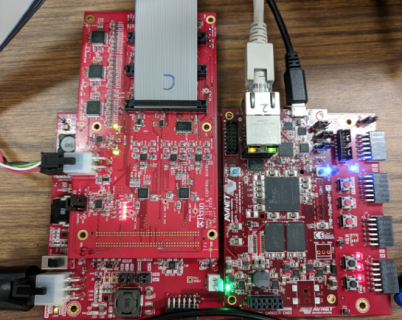 The HL-LHC is a future project of the LHC, where the operation of the ATLAS detector will be extremely challenging because of the increased luminosity. Therefore, it is important to upgrade a large part of the detector, and in particular to develop a new all-silicon Inner Tracker (ITK), composed of pixel and strip layers, a centerpiece of the ongoing upgrade activities for ATLAS. The Penn group has been significantly involved in the ITK strip ASIC group, working for the design of three ASIC chips. I have studied the behavioral modeling of the chips in hardware simulation, implementing all functionalities (logic circuits) and optimizing the data packet structure for the chips to accommodate trigger-rate and latency constraints.
The HL-LHC is a future project of the LHC, where the operation of the ATLAS detector will be extremely challenging because of the increased luminosity. Therefore, it is important to upgrade a large part of the detector, and in particular to develop a new all-silicon Inner Tracker (ITK), composed of pixel and strip layers, a centerpiece of the ongoing upgrade activities for ATLAS. The Penn group has been significantly involved in the ITK strip ASIC group, working for the design of three ASIC chips. I have studied the behavioral modeling of the chips in hardware simulation, implementing all functionalities (logic circuits) and optimizing the data packet structure for the chips to accommodate trigger-rate and latency constraints.
Higgs WW analysis (2011 - 2014)
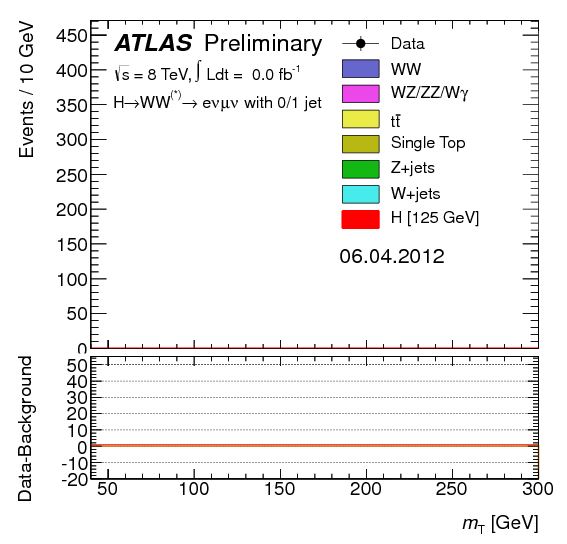
Higgs boson search
The standard model of particle physics (SM) is a theory describing elementary particles and their interactions based on gauge symmetry in EW scale. The Higgs boson was last piece of the SM before LHC began. I was an active member of the Higgs to WW analysis group until 2014, taking responsibilities on the performance study of leptons and background estimation. The Higgs boson was discovered in July 2012 by ATLAS and CMS. (Figure: credit to CERN and ATLAS)Higgs coupling measurement
After the discovery, I was focused on the measurement of the Higgs boson couplings to EW gauge bosons and fermions. Any deviation from the SM prediction may indicate the presence of new physics beyond the SM (BSM). The best measurement was achieved by the analysis group (as of 2015). So far the measured couplings are consistent with the SM prediction.Development of muon polarimeter (2009 - 2011)
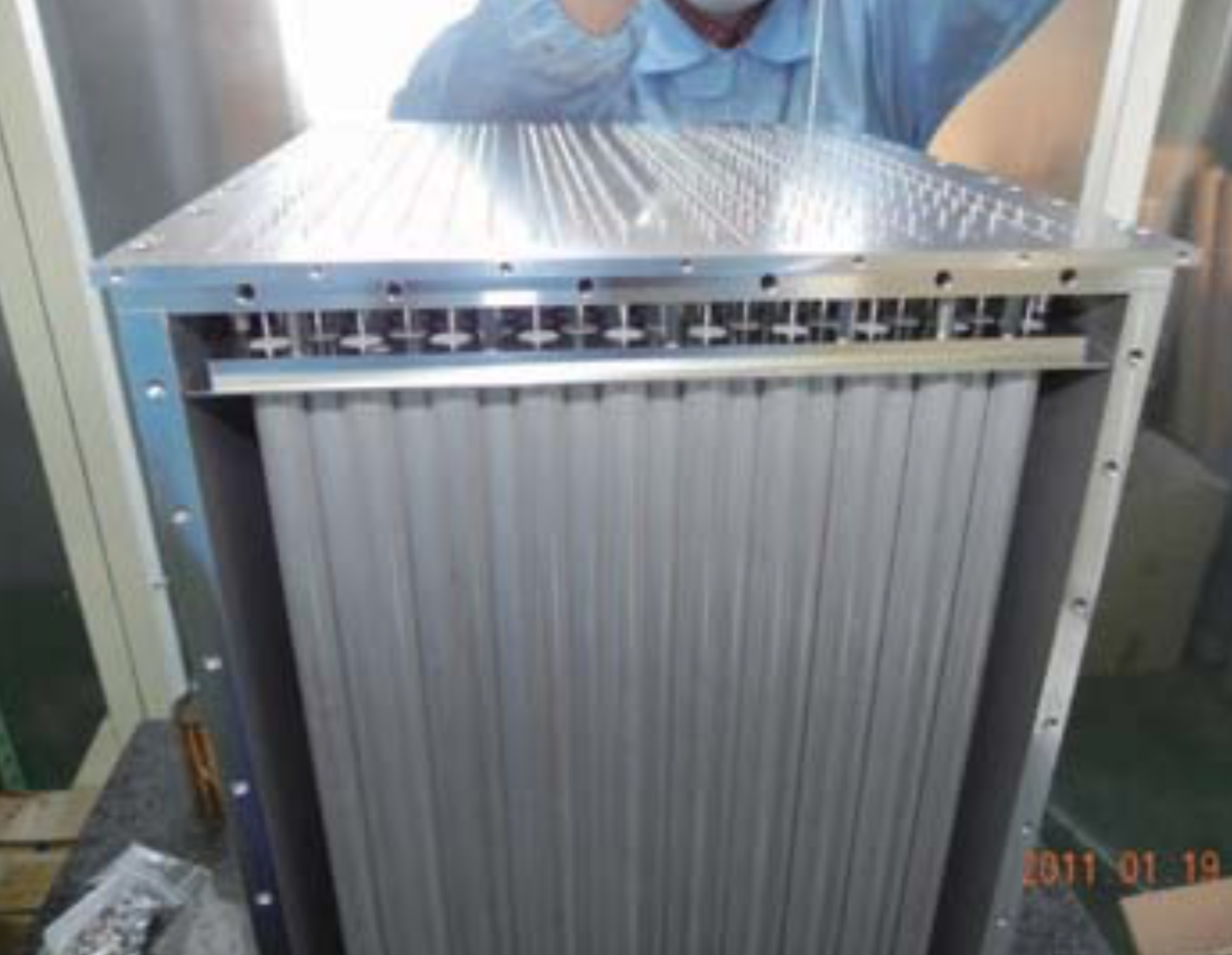 The E06 experiment targets a direct T-violation search in muon transverse polarization (PT) in charged kaon (Kμ3) decay.
I have developed a muon polarimeter, which is a drift tube tracking chamber, precisely measuring the direction of the positron emitted from the muon decay. The principle of the polarimeter is based on the fact that the positron preserves the muon spin information due to helicity conservation. The polarimeter needs some amount of material to stop incoming muons in contrast to normal drift chambers where the amount of the material inside should be minimized in order to suppress multiple scattering effects. The inner structure of the polarimeter was optimized using GEANT4 simulation. The material of the tubes was selected carefully, taking into account the effect of muon spin rotation (μSR) arising from external magnetic fields produced by nuclei in the material, as this potentially changes the muon spin direction.
The E06 experiment targets a direct T-violation search in muon transverse polarization (PT) in charged kaon (Kμ3) decay.
I have developed a muon polarimeter, which is a drift tube tracking chamber, precisely measuring the direction of the positron emitted from the muon decay. The principle of the polarimeter is based on the fact that the positron preserves the muon spin information due to helicity conservation. The polarimeter needs some amount of material to stop incoming muons in contrast to normal drift chambers where the amount of the material inside should be minimized in order to suppress multiple scattering effects. The inner structure of the polarimeter was optimized using GEANT4 simulation. The material of the tubes was selected carefully, taking into account the effect of muon spin rotation (μSR) arising from external magnetic fields produced by nuclei in the material, as this potentially changes the muon spin direction.
Commissioning of K1.1BR beamline (2010 - 2011)
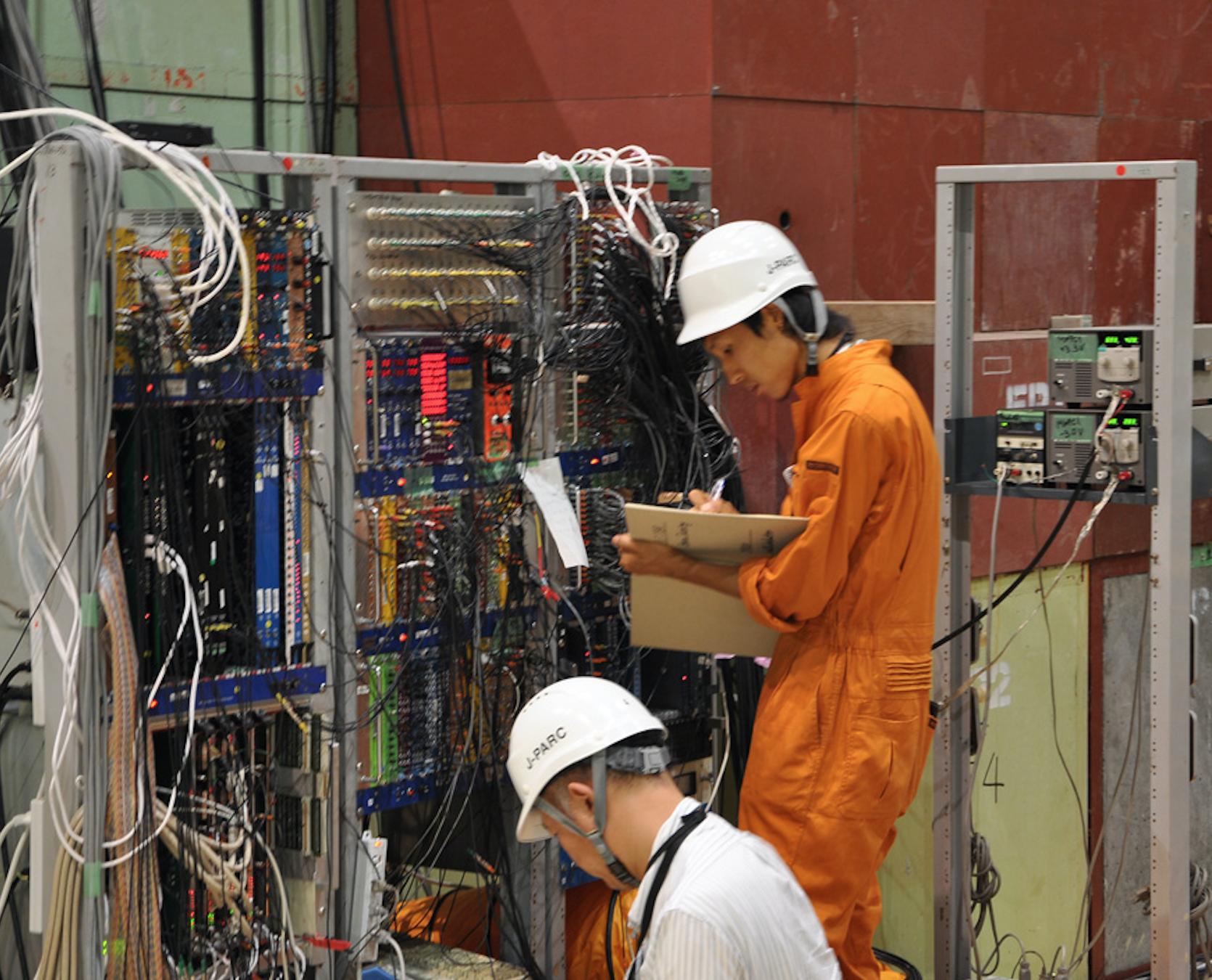 I have worked for the first beam commissioning in the K1.1BR beamline at J-PARC, taking responsibilities in preparation and installation of all beam detectors for the commissioning, such as a Hodoscope counter for the beam monitoring, a Fitch type Cherenkov counter essential to separate kaons from an extremely large fraction of pions in the beam, Time-of-Flight counters for β measurement, MWPCs for the beam profiling, and an Air Cherenkov counter for the positron discrimination. The Hodoscope was the first detector that I fully designed and built myself. It consists of ∼ 24 plastic scintillation counters and 1/2 inch PMTs. In addition to detector preparation, I have also worked on the DAQ system and have provided various triggers (proton, kaon, pion, muon and positron) for the beamline users for test experiments. I have also contributed to the optimization study of the dipole and quadrupole magnets in the beamline. The extraction of a high rate/purity kaon beam was achieved.
I have worked for the first beam commissioning in the K1.1BR beamline at J-PARC, taking responsibilities in preparation and installation of all beam detectors for the commissioning, such as a Hodoscope counter for the beam monitoring, a Fitch type Cherenkov counter essential to separate kaons from an extremely large fraction of pions in the beam, Time-of-Flight counters for β measurement, MWPCs for the beam profiling, and an Air Cherenkov counter for the positron discrimination. The Hodoscope was the first detector that I fully designed and built myself. It consists of ∼ 24 plastic scintillation counters and 1/2 inch PMTs. In addition to detector preparation, I have also worked on the DAQ system and have provided various triggers (proton, kaon, pion, muon and positron) for the beamline users for test experiments. I have also contributed to the optimization study of the dipole and quadrupole magnets in the beamline. The extraction of a high rate/purity kaon beam was achieved.